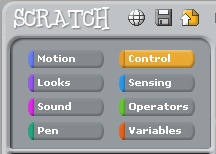Creative Coders Club on Monday was one of our best sessions ever. The kids were really creative and funny and fun to work with. The kids that came were all returnees and familiar with Scratch. It was their first time working with Scratch 3.0 and despite a few grumblings about where familiar tools went, they were able to create some creative projects. For such young people, they really seem upset about the changes to their coding environment. I’m sure they will get used to the new version and not look back.
When I was looking for a project this month I noticed the tutorial from Cartoon Network on Animating an Adventure Game. I knew the Creative Coders had been wanting to make an adventure-type game. I added this option to our January studio and went through the tutorial myself so I could field any issues. It has some fun character Sprites but turns out to be a simple “collect the gems” game. I felt it was a nice option for the club.
I also looked at the Scratch Design Studio for January. I’ve been looking at the prompts each month since the Scratch Conference in August, hoping to find one that would work for this club. The current theme is the Year 3000. I felt it would really bring out their imagination and creativity.
I started out our meeting with a “Happy New Year” and a question for them. Did things seem different now that it was 2019 or did things just seem the same? I told them that when I was their age, computers weren’t for kids and that 500 years ago books weren’t for kids either. Then we brainstormed about what the year 3000 would be like. That was the first hook.
Then I read them the Scratch Design Studio description. I really liked some of the questions it asks, like what will food be? like or how will we dance? It sparks the imagination. They shared their ideas and I had a difficult time getting them to not share all at once.
Next, I showed them the project I made about the year 3000.

My sample Year 3000 project
The other hook was the text-to-speech extension in Scratch 3.0.  I had read that some of the tools from Scratch 2.0 – like music and pen blocks – had been moved into the extensions section. When I went looking, I found the text-to-speech extension. It is easy to implement and works great.
I had read that some of the tools from Scratch 2.0 – like music and pen blocks – had been moved into the extensions section. When I went looking, I found the text-to-speech extension. It is easy to implement and works great.
I knew it would be a hit with the Creative Coders, and I was right. (My only worry would be about the appropriateness of the middle school students – and I let them know, a few times, what my expectations were).
Everyone incorporated text-to-speech in their project and everyone used it appropriately. Whew.
There is not much time in an hour to imagine and create a project but the kids managed to work hard and when I told them they had only 10 minutes to get something ready to share, a few of them revised their big ideas into something manageable. Two (of ten) said they would finish later.
In the last ten minutes, I showcased the projects they made and added to our January 2019 studio. We laughed and enjoyed each other’s creativity and imagination.

The very funny “So boring” Year 3000.

Another very funny text-to-speech Year 3000 project.
I highly recommend trying out the text-to-speech extension blocks and the different voices. It is a little tricky to have the “text-to-speech” and “say” blocks sync up (like closed-captioning) but is worth it to be able to see and hear the project.
I hope some of them submit their projects to the Scratch Design Studio and I hope next months SDS theme is just as fun.
Happy New Year and kudos to the Scratch team for a great new version!







 After introducing the same concepts of defining rules in code, (and Code Club) the first thing we tried was Motion blocks (ie moving a Sprite with the spacebar). And then we added Looks (ie change color).
After introducing the same concepts of defining rules in code, (and Code Club) the first thing we tried was Motion blocks (ie moving a Sprite with the spacebar). And then we added Looks (ie change color).
 And finally, the awesome: Sounds forever!
And finally, the awesome: Sounds forever!


